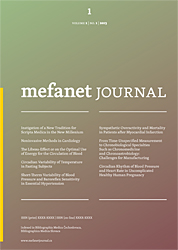
MEFANET Journal 2016; 4(2): 64
EDITORIAL MATERIAL
Editor’s preface
Daniel Schwarz
Institute of Biostatistics and Analyses, Faculty of Medicine, Masaryk University, Brno, Czech Republic
schwarz@iba.muni.cz
It is with great pleasure that we present the 2nd 2016 issue of the MEFANET Journal (MJ). MJ is dedicated to provide readers around the world with high quality peer-reviewed articles on a wide variety of topics related to applications of computer science and technology-enhanced learning in medical education. Its mission is to become the premier vehicle for disseminating information about MEdical FAculties NETwork (www.mefanet.cz), which covers all Czech and Slovak medical faculties as well as schools or faculties of health care sciences.
This second issue encompasses a tutorial, three original articles and an editorial report. The tutorial by Schwarz & Kavia exemplifies the multidisciplinarity of medical education. The authors describe successful implementation of user stories in the early stage of a European project aiming at widening access to virtual educational scenarios. The user stories are one of the primary development artifacts which are typically encountered in agile software programming teams – the tutorial demonstrates, however, their use by developers of virtual scenarios engaged in clinical reasoning and critical thinking skills. Karolyi et al. focus on text mining algorithms and demonstrate their use in an interesting case study dealing with rehabilitation and physical medicine. The original article by Pokorná et al. identifies the level of emotional intelligence in nurses and utilizes data analytics to uncover that the age, experience and education is an important factor in nurses’ emotional intelligence. Hudáková et al. describe the nursing study programmes in Slovakia and illustrate the constant need for further work and evidence supporting the academic education of nurses. The editorial by Chlupová et al. addresses the 8th AKUTNE.CZ Annual Congress, which was held in Brno in November 2016 and which attracted more than 920 participants interested in acute medicine and various medical simulation modalities.
I would like to extend my sincere gratitude to the editorial board members and reviewers, without whom this issue would not have been possible. I would like to see the complete fourth volume of the MEFANET Journal as an additional valuable resource for the MEFANET community and a stimulus for further research into the vibrant area of medical education science. The wide range of topics presented in this issue emphasizes the complexity of the use of information and communication technologies in medical education. Readers are encouraged to submit both comments on these articles and their own relevant manuscripts.
December 2016

Daniel Schwarz
Editor-in-chief










